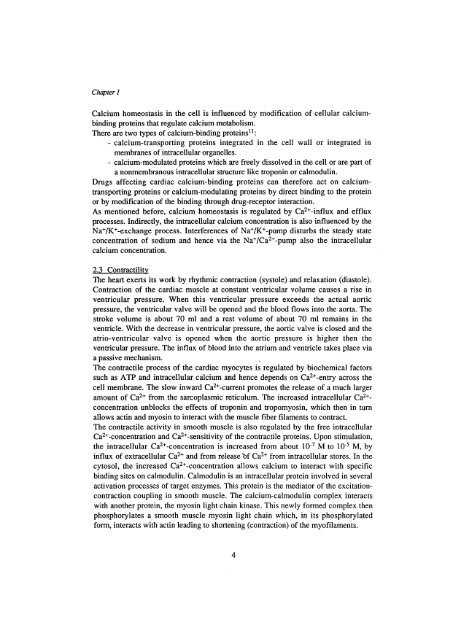synthesis and in vitro pharmacology of a series of histamine h2 ...
synthesis and in vitro pharmacology of a series of histamine h2 ...
synthesis and in vitro pharmacology of a series of histamine h2 ...
Create successful ePaper yourself
Turn your PDF publications into a flip-book with our unique Google optimized e-Paper software.
Chapter 1<br />
Calcium homeostasis <strong>in</strong> the cell is <strong>in</strong>fluenced by modification <strong>of</strong> cellular calciumb<strong>in</strong>d<strong>in</strong>g<br />
prote<strong>in</strong>s that regulate calcium metabolism.<br />
There are two types <strong>of</strong> calcium-b<strong>in</strong>d<strong>in</strong>g prote<strong>in</strong>s 11<br />
:<br />
- calcium-transport<strong>in</strong>g prote<strong>in</strong>s <strong>in</strong>tegrated <strong>in</strong> the cell wall or <strong>in</strong>tegrated <strong>in</strong><br />
membranes <strong>of</strong> <strong>in</strong>tracellular organelles.<br />
- calcium-modulated prote<strong>in</strong>s which are freely dissolved <strong>in</strong> the cell or are part <strong>of</strong><br />
a nonmembranous <strong>in</strong>tracellular structure like tropon<strong>in</strong> or calmodul<strong>in</strong>.<br />
Drugs affect<strong>in</strong>g cardiac calcium-b<strong>in</strong>d<strong>in</strong>g prote<strong>in</strong>s can therefore act on calciumtransport<strong>in</strong>g<br />
prote<strong>in</strong>s or calcium-modulat<strong>in</strong>g prote<strong>in</strong>s by direct b<strong>in</strong>d<strong>in</strong>g to the prote<strong>in</strong><br />
or by modification <strong>of</strong> the b<strong>in</strong>d<strong>in</strong>g through drug-receptor <strong>in</strong>teraction.<br />
As mentioned before, calcium homeostasis is regulated by Ca 2+<br />
-<strong>in</strong>flux <strong>and</strong> efflux<br />
processes. Indirectly, the <strong>in</strong>tracellular calcium concentration is also <strong>in</strong>fluenced by the<br />
Na +<br />
/K +<br />
-exchange process. Interferences <strong>of</strong> Na +<br />
/K +<br />
-pump disturbs the steady state<br />
concentration <strong>of</strong> sodium <strong>and</strong> hence via the Na +<br />
/Ca 2+<br />
-pump also the <strong>in</strong>tracellular<br />
calcium concentration.<br />
2.3 Contractility<br />
The heart exerts its work by rhythmic contraction (systole) <strong>and</strong> relaxation (diastole).<br />
Contraction <strong>of</strong> the cardiac muscle at constant ventricular volume causes a rise <strong>in</strong><br />
ventricular pressure. When this ventricular pressure exceeds the actual aortic<br />
pressure, the ventricular valve will be opened <strong>and</strong> the blood flows <strong>in</strong>to the aorta. The<br />
stroke volume is about 70 ml <strong>and</strong> a rest volume <strong>of</strong> about 70 ml rema<strong>in</strong>s <strong>in</strong> the<br />
ventricle. With the decrease <strong>in</strong> ventricular pressure, the aortic valve is closed <strong>and</strong> the<br />
atrio-ventricular valve is opened when the aortic pressure is higher then the<br />
ventricular pressure. The <strong>in</strong>flux <strong>of</strong> blood <strong>in</strong>to the atrium <strong>and</strong> ventricle takes place via<br />
a passive mechanism.<br />
The contractile process <strong>of</strong> the cardiac myocytes is regulated by biochemical factors<br />
such as ATP <strong>and</strong> <strong>in</strong>tracellular calcium <strong>and</strong> hence depends on Ca 2+<br />
-entry across the<br />
cell membrane. The slow <strong>in</strong>ward Ca 2+<br />
-current promotes the release <strong>of</strong> a much larger<br />
2 +<br />
amount <strong>of</strong> Ca<br />
from the sarcoplasmic reticulum. The <strong>in</strong>creased <strong>in</strong>tracellular Ca 2+<br />
-<br />
concentration unblocks the effects <strong>of</strong> tropon<strong>in</strong> <strong>and</strong> tropomyos<strong>in</strong>, which then <strong>in</strong> turn<br />
allows act<strong>in</strong> <strong>and</strong> myos<strong>in</strong> to <strong>in</strong>teract with the muscle fiber filaments to contract.<br />
The contractile activity <strong>in</strong> smooth muscle is also regulated by the free <strong>in</strong>tracellular<br />
Ca 2+<br />
-concentration <strong>and</strong> Ca 2+<br />
-sensitivity <strong>of</strong> the contractile prote<strong>in</strong>s. Upon stimulation,<br />
the <strong>in</strong>tracellular Ca 2+<br />
-concentration is <strong>in</strong>creased from about 10~ 7<br />
M to 10~ 5<br />
M, by<br />
2 +<br />
<strong>in</strong>flux <strong>of</strong> extracellular Ca <strong>and</strong> from release M Ca 2+<br />
from <strong>in</strong>tracellular stores. In the<br />
cytosol, the <strong>in</strong>creased Ca 2+<br />
-concentration allows calcium to <strong>in</strong>teract with specific<br />
b<strong>in</strong>d<strong>in</strong>g sites on calmodul<strong>in</strong>. Calmodul<strong>in</strong> is an <strong>in</strong>tracellular prote<strong>in</strong> <strong>in</strong>volved <strong>in</strong> several<br />
activation processes <strong>of</strong> target enzymes. This prote<strong>in</strong> is the mediator <strong>of</strong> the excitationcontraction<br />
coupl<strong>in</strong>g <strong>in</strong> smooth muscle. The calcium-calmodul<strong>in</strong> complex <strong>in</strong>teracts<br />
with another prote<strong>in</strong>, the myos<strong>in</strong> light cha<strong>in</strong> k<strong>in</strong>ase. This newly formed complex then<br />
phosphorylates a smooth muscle myos<strong>in</strong> light cha<strong>in</strong> which, <strong>in</strong> its phosphorylated<br />
form, <strong>in</strong>teracts with act<strong>in</strong> lead<strong>in</strong>g to shorten<strong>in</strong>g (contraction) <strong>of</strong> the my<strong>of</strong>ilaments.<br />
4

















